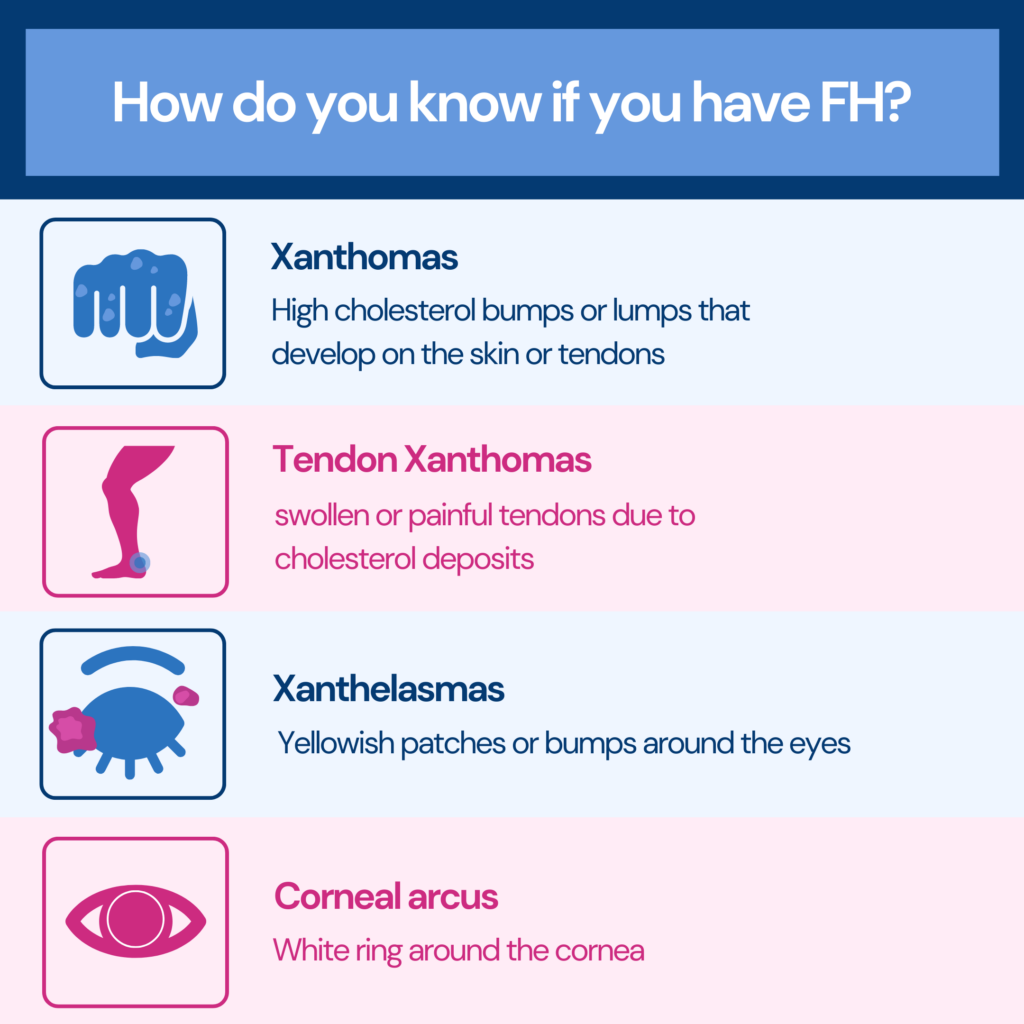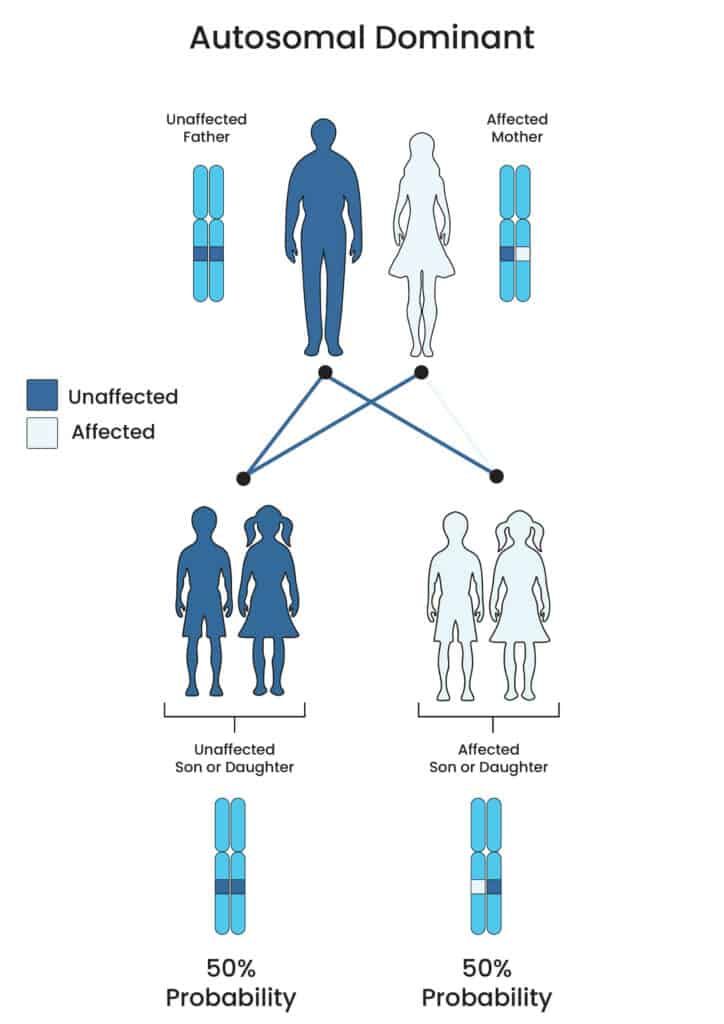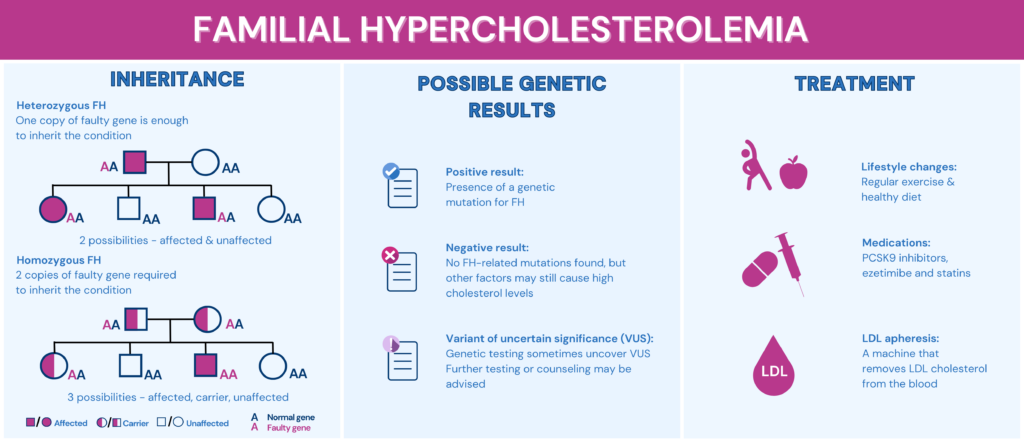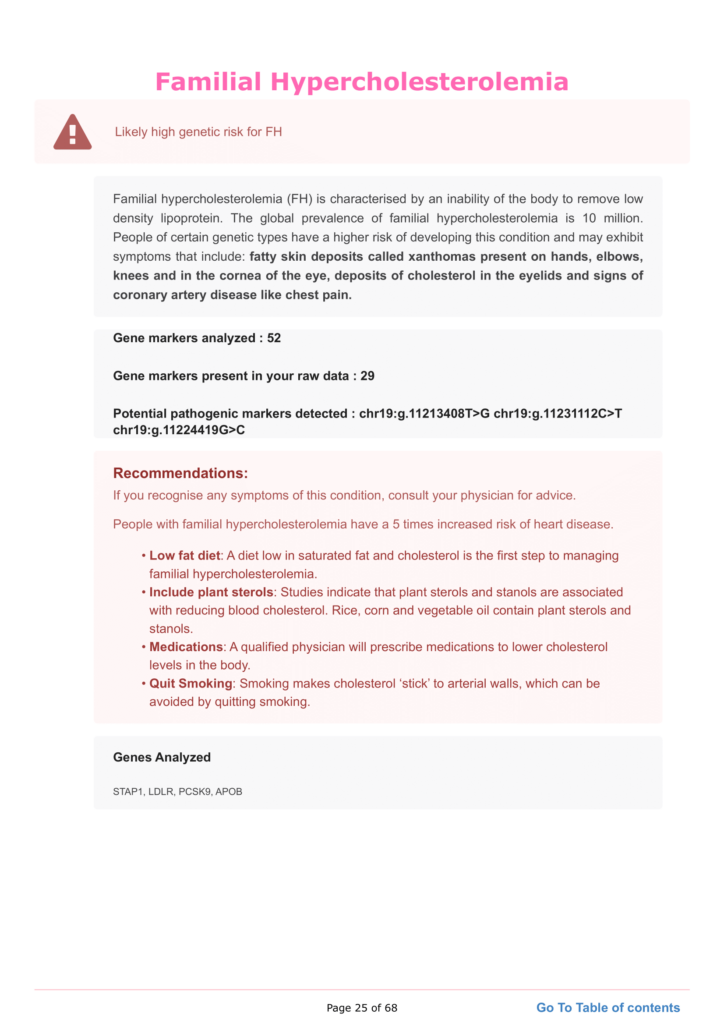Did you know that your genes can hold vital clues about your risk for certain health conditions? One such condition is familial hypercholesterolemia, a genetic disorder affecting cholesterol levels and increasing heart disease risk. In this blog post, we'll explain how familial hypercholesterolemia genetic testing can help you better understand your genetic risk for this condition. Whether you're new to genetic testing or seeking more information about your cholesterol levels, this article will be your guide.
Did You Know? Your 23andMe DNA Data includes 700,000 markers, which can be used to learn everything about your health and disease risk, including information on familial hypercholesterolemia. Learn more.
What Is Familial Hypercholesterolemia?
Familial Hypercholesterolemia (FH) is a genetic disorder.
It causes high cholesterol levels in the blood, specifically low-density lipoprotein (LDL) cholesterol, commonly known as "bad" cholesterol.
This condition inhibits the body's ability to remove LDL cholesterol from the bloodstream.
Consequently, it raises the risk of developing cardiovascular disorders like heart attacks and strokes at a young age.
Causes
Mutations in certain genes that control cholesterol metabolism in the body are the main cause of FH.
The LDL receptor gene (LDLR) is the most common gene affected by FH, with the apolipoprotein B gene (APOB) and the proprotein convertase subtilisin/kexin type 9 gene (PCSK9) following closely behind.
These mutations disrupt the regular activity of these genes, leading to difficulties in removing LDL cholesterol.
Symptoms
The symptoms of FH are often silent and may go unnoticed until complications arise.
Individuals with FH have high LDL cholesterol levels from birth, leading to the development of fatty deposits called plaques in the arteries.
Common signs and symptoms of FH include:
- Xanthomas: Xanthomas are bumps or lumps that develop on the skin or tendons due to the collection of high cholesterol. They can appear in the following areas:
- Knuckles
- Elbows
- Knees
- Tendon xanthomas: Tendon xanthomas are swollen or painful tendons caused by cholesterol deposits. The most commonly affected area is the Achilles tendon, which can cause discomfort or pain, especially when wearing shoes or engaging in physical activities.
- Xanthelasmas: Xanthelasmas are yellowish patches or bumps that form around the eyes. These cholesterol deposits in the skin can be seen as flat or slightly raised areas. They are often symmetrically distributed around both eyes.
- Corneal arcus: The corneal arcus is a white or grayish ring that develops around the cornea's outer edge, the eye's transparent front part. This can be observed during an eye examination and may indicate the presence of FH.

Familial Hypercholesterolemia Inheritance
FH is characterized by non-sex chromosomal or autosomal dominant nature.
If one parent has the condition, the child has a 50% chance of getting it.
This condition is commonly referred to as Heterozygous Familial Hypercholesterolemia (HeFH).

On the other hand, in Homozygous Familial Hypercholesterolemia (HoFH), both parents carry the FH gene, leading to a higher chance of their child experiencing this disorder.
Paul N. Hopkins, MD, a professor at the University of Utah School of Medicine, highlights that males with untreated HeFH face a 50% chance of experiencing a heart attack.
This risk is specifically associated with reaching the age of 45.
Females may encounter this occurrence between the ages of 55 and 60.
Familial Hypercholesterolemia Genetic Testing
Genetic testing for FH is crucial in diagnosing the condition, identifying affected individuals, and providing appropriate management strategies.
The test analyzes specific genes associated with FH and detects genetic mutations that cause the disorder.
What Are The Criteria For Familial Hypercholesterolemia Genetic Testing?
The criteria for FH genetic testing vary depending on the clinical guidelines. However, some common criteria include:
Simon Broom Diagnostic Criteria for FH
The Simon Broome criteria consider a variety of parameters, including cholesterol levels, clinical symptoms, molecular diagnosis, and family history. Focusing on determining the risk of severe CHD in individuals with Familial Hypercholesterolemia, these criteria are summarised in the table below.
| Diagnosis of definite FH cases |
| Total cholesterol levels above 290 mg/dL (7.5 mmol/L) or LDL-cholesterol levels above 190 mg/dL (4.9 mmol/L) in adultsTotal cholesterol levels above 260 mg/dL (6.7 mmol/L) or LDL-cholesterol levels above 155 mg/dL (4.0 mmol/L) in children under 16 years of age |
| ➕ |
| Tendon xanthomas in a patient or a 1st-degree relative (parent, sibling, child) or in a 2nd-degree relative (grandparent, uncle, aunt)Evidence of specific gene mutations related to LDLR, PCSK9, or APOB |
| Diagnosis of probable FH cases |
| Total cholesterol levels above 290 mg/dL (7.5 mmol/L) or LDL-cholesterol levels above 190 mg/dL (4.9 mmol/L) in adultsTotal cholesterol levels above 260 mg/dL (6.7 mmol/L) or LDL-cholesterol levels above 155 mg/dL (4.0 mmol/L) in children under 16 years of age |
| ➕ |
| Family history of early myocardial infarction (MI) before the age of 50 in a close relative (2nd degree) or before the age of 60 in a direct relative (1st degree)Family history of elevated total cholesterol levels > 290 mg/dL (7.5 mmol/L) in adult relatives or > 260 mg/dL (6.7 mmol/L) in children or siblings under 16) |
The Dutch Diagnostic Criteria for FH
The Dutch Diagnostic Criteria provide a modified approach to the Simon-Broome criteria by adding a scoring system and considering the underlying molecular defect of Familial Hypercholesterolemia. The table below summarizes the criteria, including family history, clinical history, physical examination, LDL cholesterol levels, and DNA analysis, enabling a more comprehensive diagnosis of FH.
| Criteria | Score |
| Family History | |
| First-degree relative with premature coronary and vascular disease (men ≤55 years, women ≤60 years) | 1 |
| First-degree relative with known LDL-cholesterol ≥95th percentile for age and gender | 2 |
| First-degree relative with tendon xanthomata and corneal arcus | |
| Children aged ≤18 years with known LDL-cholesterol ≥95th percentile for age and gender | |
| Clinical History | |
| Patient with premature coronary artery disease | 2 |
| Patient with premature cerebral or peripheral vascular disease | 1 |
| Physical Examination | |
| Tendon Xanthomas | 6 |
| Corneal arcus at age ≤45 years | 4 |
| LDL Cholesterol (mmol/L) (mg/dL) | |
| LDL-C ≥ 330 mg/dL (8.5 mmol/L) | 8 |
| LDL-C 250 - 329 mg/dL (6.5 - 8.4 mmol/L) | 5 |
| LDL-C 190 - 249 mg/dL (5.0 - 6.4 mmol/L) | 3 |
| LDL-C 155 - 189 mg/dL (4.0 - 4.9 mmol/L) | 1 |
| DNA Analysis | |
| Functioning mutations in the genes LDLR, APOB, and PCSK9 | 8 |
| Stratification | Total Score |
| Definite Familial Hypercholesterolemia | >8 |
| Probable Familial Hypercholesterolemia | 6-8 |
| Possible Familial Hypercholesterolemia | 3-5 |
| Unlikely Familial Hypercholesterolemia | <3 |
The MEDPED Diagnostic Criteria for FH
The MEDPED Diagnostic Criteria for Familial Hypercholesterolemia use age- and relative-specific total cholesterol values. It highlights the lower diagnostic cut-off levels for total cholesterol in persons with first-degree, second-degree, or third-degree relatives when compared to the general population cut-off levels. These factors help identify people at risk for FH based on their total cholesterol levels.
| Age (years) | First-degree relative with FH | Second-degree relative with FH | Third-degree relative with FH | General population |
| <20 | 220 mg/dL(5.7 mmol/L) | 230 mg/dL(5.9 mmol/L) | 240 mg/dL(6.2 mmol/L) | 270 mg/dL(7.0 mmol/L) |
| 20-29 | 240 mg/dL(6.2 mmol/L) | 250 mg/dL(6.5 mmol/L) | 260 mg/dL(6.7 mmol/L) | 290 mg/dL(7.5 mmol/L) |
| 30-39 | 270 mg/dL(7.0 mmol/L) | 280 mg/dL(7.2 mmol/L) | 290 mg/dL(7.5 mmol/L) | 340 mg/dL(8.8 mmol/L) |
| ≥40 | 290 mg/dL(7.5 mmol/L) | 300 mg/dL(7.8 mmol/L) | 310 mg/dL(8.0 mmol/L) | 360 mg/dL(9.3 mmol/L) |
Why Is It Important?
Genetic testing for FH is essential for several reasons:
- Early detection: Identifying FH at an early age allows for early intervention and treatment, reducing the risk of cardiovascular complications.
- Family screening: Genetic testing helps identify other family members who may be at risk and require preventive measures.
- Personalized treatment: Genetic testing results guide healthcare professionals in developing individualized treatment plans for FH patients.
Hand-picked content for you
The Top 3 Genetic Liver Diseases Of 2023
How Is It Done?
Genetic testing for FH is typically conducted using a targeted approach focused on the known genes associated with the condition.
Three genes (LDLR, APOB, and PCSK9) are known to cause FH.
The process begins by identifying people with FH through clinical diagnosis, which includes a lipid test, physical examination, and evaluation of family history.
Once FH is confirmed in an individual, genetic testing can be extended to other family members through cascade screening.
This approach identifies the specific genetic variant responsible for FH within the family.
Genetic testing is usually done under the supervision of a trained genetic counselor or a healthcare practitioner with skills in genetic testing.
How Much Does Genetic Testing For Familial Hypercholesterolemia Cost?
According to NCBI, the cost of genetic testing for FH varies depending on the perspective and specific circumstances.
From the healthcare provider's standpoint, the simulation considered the direct costs of medical care.
Recently, many laboratories have introduced next-generation sequencing targeted panels for FH cases.
These panels offer genetic testing at a cost of less than $500.
Subsequent testing for relatives who may carry a known pathogenic variant is typically more affordable.
Their mentioned model of genetic testing for FH costs $250.
However, it may offer free testing for relatives within 90 days as part of the cascade testing process, particularly if they are identified as close relatives of an FH proband.
**Please note that the costs mentioned may change and vary depending on individual situations, insurance coverage, and regional differences.**
Familial Hypercholesterolemia Genetic Testing Results
Individuals who undergo FH genetic testing receive precise results that provide essential data about their genetic makeup and risk of developing cardiovascular problems.
What Are The Possible Results?
The possible genetic testing results for FH include the following:
- Positive result
- Negative result
- A variant of uncertain significance (VUS)
What Do They Mean?
- Positive result: A positive result shows the presence of a genetic mutation associated with FH. This confirms the diagnosis of FH and the increased risk of cardiovascular complications.
- Negative result: If the result is negative, no FH-related mutations have been identified. However, it is still possible for other genetic or non-genetic factors to cause high cholesterol levels.
- Variant of uncertain significance (VUS): In some cases, genetic testing may identify a genetic variant that is not well understood or lacks sufficient evidence to determine its significance. Additional testing or genetic counseling may be recommended in such cases.

What Can You Do With The Test Results?
Access to genetic testing results enables individuals to take charge of their health and proactively make informed decisions. With FH genetic testing results, individuals can take some of the following steps:
- Show the result to healthcare professionals specializing in FH management to develop personalized treatment plans and monitoring schedules.
- Adopt a heart-healthy lifestyle. Make required changes, such as exercising regularly, quitting smoking, and keeping a healthy weight.
- Raise awareness, facilitate their FH evaluation, and share the results with family members, especially close relatives.
- Follow your healthcare professionals prescribed medications (such as statins or other cholesterol-lowering drugs).
Does 23andMe Do Familial Hypercholesterolemia Genetic Testing?
The 23andMe genetic testing service provides a specialized report called the Familial Hypercholesterolemia Genetic Health Risk Report.
This report focuses on detecting specific genetic variants associated with FH, characterized by high LDL cholesterol levels and a higher chance of heart disease.
To access this report, individuals can undergo genetic testing by purchasing and using the 23andMe Health + Ancestry Set.
About Xcode Life Gene Health Report
The health panel of Xcode Life includes 45+ conditions. 52 significant markers are analyzed for Familial Cholesterolemia.
If you have done an ancestry genetic test with companies like 23andMe, AncestryDNA, MyHeritage, etc., you can learn your FH risk gene status in just 3 steps.
- Download your DNA raw data from your service provider
- Add the “Gene Health” report to your cart (or the Xcode Life Genome Pack for a 70% discount)
- Upload your raw data and receive your results within 24 hours.

No DNA Test? No Problem
Not yet tested?
If you're new to the world of genetic testing, we've got you covered!
You can now get your ancestry DNA kits at an additional discount!
By following the link provided in this article, you can purchase a DNA kit at 10% OFF (the discount will be reflected when you add the product).
This will ensure that you have everything you need to embark on your genetic journey.
- 23andMe Ancestry Kit
- 23andMe Health + Ancestry Kit
- AncestryDNA Kit (currently no additional discount available)
Once you receive your kits, you can follow the instructions given by the respective service providers to collect your sample and ship it.
After you receive your DNA test results from the kit, you can upload your DNA data to our secure platform.
A happy customer
I recently used xcode life to get one of their gene health reports. My experience was very good. I received the report the same morning within the time frame they stated. It was well detailed giving clear and easy to understand information and came in PDF form so it was easy to print. My personal experience has been brilliant and I would use them again.
- Ben Duncombe
What Are The 3 Possible Genotypes For Familial Hypercholesterolemia?
FH can be classified into three possible genotypes, such as:
HoFH: The most severe form of FH occurs when an individual inherits two copies of the defective gene from both parents, resulting in a specific genotype.
HeFH: The heterozygous genotype is a common and less severe form of FH. It happens when an individual acquires one copy of the faulty gene from one parent.
CeFH (Compound heterozygous FH): This genotype occurs when an individual inherits two mutated genes responsible for FH, one from each parent. It is a rare form of FH and is typically more severe than HeFH.
Overview Of Familial Hypercholesterolemia Treatment
FH treatment involves a blend of lifestyle adjustments and medication to decrease LDL cholesterol levels and reduce the risk of complications.
Here is an overview of the different treatment options for people with FH:
Lifestyle changes: Making lifestyle changes is crucial for people with FH. Lowering LDL cholesterol levels and decreasing the risk of heart disease can be achieved through these changes.
Medications: PCSK9 inhibitors and ezetimibe are alternative medications that can help people with FH who cannot reach target levels through lifestyle changes alone. Statins, the most frequently used FH medication, can also effectively lower LDL cholesterol levels.
LDL apheresis: LDL apheresis is a procedure that uses a machine to remove LDL cholesterol from the blood. It is an option for people with FH who have excessively high LDL cholesterol levels that cannot be regulated by lifestyle changes or medication.
Summary: Familial Hypercholesterolemia Genetic Testing
Familial Hypercholesterolemia is a genetic disorder that results in high levels of LDL cholesterol in the bloodstream, developing the chances of cardiovascular diseases. This condition occurs from mutations within genes responsible for regulating cholesterol metabolism, namely LDLR, APOB, and PCSK9.
Diagnosing FH involves genetic testing, which analyzes specific genes associated with the condition to detect genetic mutations. There are various criteria for FH genetic testing, including cholesterol levels, family history, and specific symptoms like xanthomas and corneal arcus.
Genetic testing is crucial for early detection, family screening, and developing personalized treatment plans for individuals with FH. It is typically performed under the guidance of a genetic counselor or healthcare practitioner.
The cost of genetic testing for FH varies, but recent advancements with some labs offering testing for less than $500. Insurance coverage and regional differences can affect the cost.
Genetic testing can provide accurate information about a person's genetic makeup and risk of developing heart disease. Positive results confirm the presence of FH-associated mutations, while negative results signify the absence of known mutations. VUS results require further testing or genetic counseling.
With genetic testing results, individuals can consult with healthcare professionals to develop personalized treatment plans, adopt a heart-healthy lifestyle, raise awareness among family members, and follow prescribed medications.
References
https://www.cdc.gov/genomics/disease/fh/FH.htm
https://www.ncbi.nlm.nih.gov/pmc/articles/PMC2873730/
https://www.genome.gov/Genetic-Disorders/Familial-Hypercholesterolemia
https://www.ncbi.nlm.nih.gov/pmc/articles/PMC8403726/
https://www.ncbi.nlm.nih.gov/pmc/articles/PMC3104361/
https://www.ncbi.nlm.nih.gov/pmc/articles/PMC4217354/






